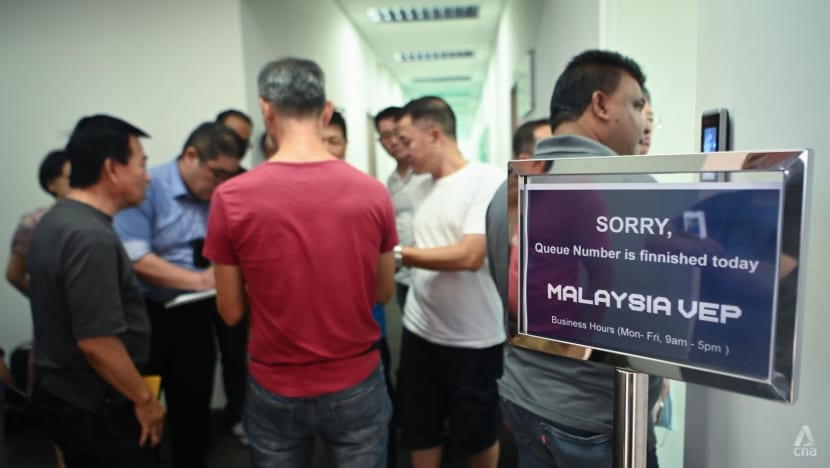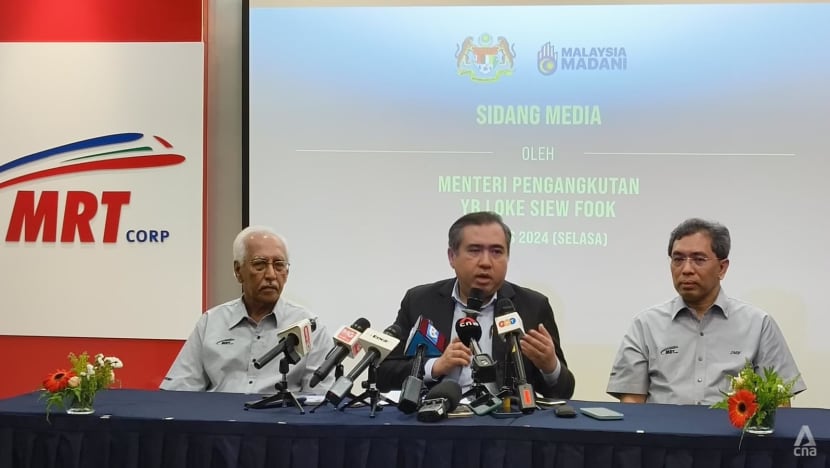Malaysia transport minister tasks vendor for VEP information counter in Woodlands to do ‘level best’ to help Singapore drivers
Mr Anthony Loke stressed that the Vehicle Entry Permit information centre in Woodlands is not run by his ministry but instead by TCSens - a vendor appointed by Malaysia’s Road Transport Department to handle queries from Singapore drivers.


This audio is generated by an AI tool.
KUALA LUMPUR: Malaysia’s Transport Minister Anthony Loke on Tuesday (Aug 20) said that he has instructed the vendor handling queries regarding the Vehicle Entry Permit (VEP) in Singapore “to do their level best to inform the public” and “facilitate the (application) process” for drivers.
He was responding to a media question on concerns raised by Singapore drivers the day before over confusion surrounding the application process for the VEP, following the opening of an information centre in Woodlands.
But Mr Loke stressed that his ministry could not do the job of TCsens – the vendor appointed by Malaysia's Road Transport Department (JPJ) to handle queries from Singapore drivers - when it came to the publicity of its office opening on Aug 19.
“The notice was given, we have asked the vendor to announce it publicly because it is an office owned by them, not run by the ministry. We cannot issue a statement on their behalf,” Mr Loke said, referring to his ministry’s silence about the opening of the information centre.
No public announcement on the exact location of the office in Woodlands was made by TCSens nor by the Malaysian authorities. Mr Loke had on Aug 1 announced that TCSens was set to work with a Singapore partner firm to open an information centre in the Republic to address queries from the drivers there.
CNA was the first to report on the exact location of the information centre on Aug 19 - 186 Woodlands Industrial Park E5 – and this led to dozens of Singaporean drivers visiting the office in the afternoon that day.
Drivers said that they got to know about the location of the information centre following the publication of CNA’s report.
Mr Loke on Tuesday said that Malaysian authorities had requested for TCSens to open the information centre in Singapore due to the sheer number of enquiries on the VEP.
“That’s why we have instructed the vendor to do their level best to inform the public in Singapore and to facilitate the process,” he said, adding that the firm had also increased the number of staff members at its call centre as well as at its office in Johor Bahru’s Danga Bay.
But a manager at the information office in Woodlands had told CNA that it was strictly an “enquiry centre”. Drivers are not able to install nor collect their radio frequency identification (RFID) tag at the office.
From Oct 1, all foreign-registered vehicles entering Malaysia by land from Singapore will be required to use the VEP. Vehicles that have been registered will be fitted with an RFID tag that costs RM10 (US$2.28).
Action will be taken against the driver of any foreign motor vehicle without a VEP entering or in Malaysia from Oct 1, with anyone found guilty of the offence liable for a fine of up to RM2,000 or jailed for up to six months.
Mr Loke said that with the impending deadline, the rush for applications and queries was expected.
“If we did not set a deadline, nobody would be serious in applying for that system. Again, I stress this is not new … Anyway, we will monitor closely, and we will ensure there will be a smooth implementation rollout by Oct 1,” he said.
At the same time, Mr Loke sought to assure Singaporeans that the VEP was not being implemented to discourage them from coming to Johor Bahru.
The VEP, implemented in 2019 but not enforced, will enable the Malaysian government to track foreign vehicles that enter or leave the country and get motorists to settle summonses before they leave.
“We know it is important for Singaporeans to come in by droves because it is important for Johor Bahru’s economy. Again, we think this is a system that will be better for the long term, but it will take some time for us to implement it smoothly,” he said.

RTS COMPLETION AT 83 PER CENT
Mr Loke spoke to the media after witnessing the signing of a sales and purchase agreement between Malaysia Rapid Transit System Sdn Bhd (MRTS) and Coronade Properties Sdn Bhd (CPSB).
The agreement would see MRTS acquire 781 parking bays at Coronation Square - a mixed development in Johor Bahru that is still under construction - from CPSB, with the parking spaces dedicated to commuters of the upcoming Johor Bahru-Singapore Rapid Transit System (RTS) Link.
On the RTS link, Mr Loke said that the completion rate of the project as of end-July was at 83 per cent, although this was only for the physical construction of the link.
He also said that both Malaysia and Singapore had a similar completion rate for the project.
“The handover to the system provider has to be done by the end of this year,” he said.
The RTS Link is expected to start passenger service by the end of 2026. It aims to ease traffic congestion on the Causeway – one of the world's busiest border crossings – by ferrying up to 10,000 passengers an hour each way on a journey that takes about five minutes.
It is estimated to cost RM10 billion, with Singapore bearing 61 per cent of the cost.
Services will run between the Singapore terminus at Woodlands North station and the Malaysia terminus at Bukit Chagar station in Johor Bahru.
The Woodlands North station – which is being constructed at a maximum depth of 28m – will be connected via an underground linkway to the immigration area. On the Malaysia side, the immigration facilities will also be located at Bukit Chagar station.
This means passengers only need to clear immigration authorities once – at their point of departure. Currently, passengers need to clear immigration on arrival as well.
Fares for the RTS Link will be “determined commercially” once the shuttle service is up and running, Singapore’s then-Acting Transport Minister Chee Hong Tat said in January,
The project was originally scheduled for completion in 2024, with the Malaysia and Singapore governments signing a bilateral agreement to build the link in 2018.
But the project was suspended a number of times after the Pakatan Harapan (PH) coalition government – then led by Dr Mahathir Mohamad - came to power in Malaysia in 2018.
The project officially resumed in July 2020, with a bilateral ceremony held on the Causeway to mark the occasion. Singapore Prime Minister Lee Hsien Loong and his then-Malaysian counterpart Muhyiddin Yassin were both in attendance.
In January, Malaysia Prime Minister Anwar Ibrahim and Mr Lee - who is now Singapore’s Senior Minister - met to mark the completion of the connecting span of the project which connects both sides of the viaduct.
The two also signed commemorative plaques to symbolise the shared commitment of the rail project to improve connectivity between both countries.




















